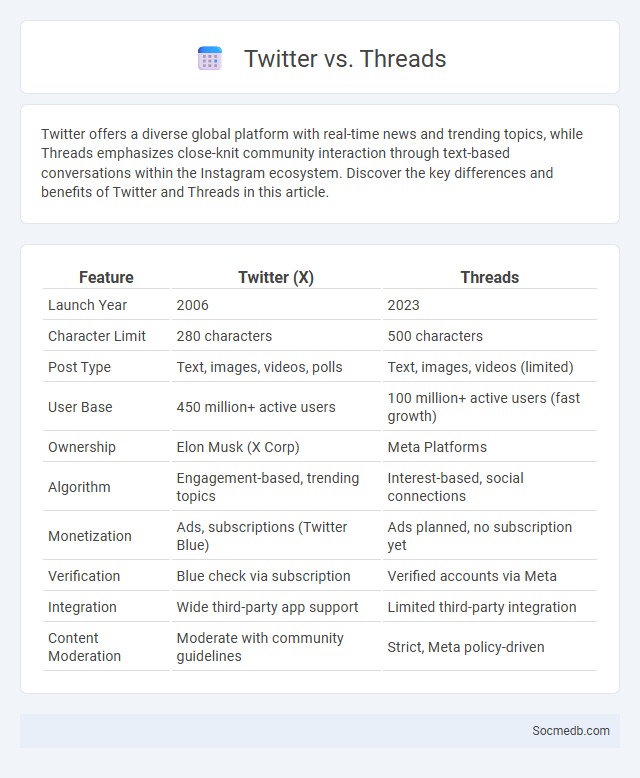
Photo illustration: Twitter vs Threads
Twitter offers a diverse global platform with real-time news and trending topics, while Threads emphasizes close-knit community interaction through text-based conversations within the Instagram ecosystem. Discover the key differences and benefits of Twitter and Threads in this article.
Table of Comparison
| Feature | Twitter (X) | Threads |
|---|---|---|
| Launch Year | 2006 | 2023 |
| Character Limit | 280 characters | 500 characters |
| Post Type | Text, images, videos, polls | Text, images, videos (limited) |
| User Base | 450 million+ active users | 100 million+ active users (fast growth) |
| Ownership | Elon Musk (X Corp) | Meta Platforms |
| Algorithm | Engagement-based, trending topics | Interest-based, social connections |
| Monetization | Ads, subscriptions (Twitter Blue) | Ads planned, no subscription yet |
| Verification | Blue check via subscription | Verified accounts via Meta |
| Integration | Wide third-party app support | Limited third-party integration |
| Content Moderation | Moderate with community guidelines | Strict, Meta policy-driven |
Overview: Twitter, Threads, and Trending Topics
Twitter and Threads dominate social media conversations, with Twitter boasting over 450 million active users and Threads rapidly growing since its launch. Trending topics on both platforms reflect real-time global interests, driven by hashtags, viral posts, and user engagement rates exceeding 70%. These platforms leverage advanced algorithms to curate personalized content, enhancing user interaction and amplifying trending discussions across diverse communities.
Platform Features: Comparing Twitter and Threads
Twitter offers real-time news updates, hashtag trending topics, and a 280-character tweet limit fostering concise communication. Threads, integrated with Instagram, emphasizes threaded conversations and multimedia sharing within a visually rich environment, supporting longer posts and enhanced community interaction. Both platforms provide unique engagement tools, but Twitter excels in live event coverage while Threads leans toward in-depth dialogues and content integration across Facebook's ecosystem.
User Experience: Navigation and Engagement
Social media platforms prioritize seamless navigation by implementing intuitive interfaces and clear content categorization, which enhance user experience and retention. Interactive features such as personalized feeds, real-time notifications, and engaging multimedia content significantly boost user engagement and time spent on the platform. Data-driven algorithms analyze user behavior to continuously optimize content relevance and streamline navigation paths, fostering deeper interaction and satisfaction.
Content Discovery: How Trending Topics Work
Trending topics on social media are determined by an algorithm that analyzes the volume, speed, and sources of posts mentioning specific keywords or hashtags within a short time frame. These algorithms prioritize content that generates rapid engagement, such as likes, shares, and comments, helping users discover popular conversations in real-time. Platforms continuously update trending lists to reflect the most current interests, ensuring relevant and timely content discovery.
Algorithm Differences: What Drives the Trends
Social media platforms utilize distinct algorithms tailored to user behavior, content type, and engagement metrics, driving unique trend dynamics across networks. Instagram prioritizes visual content and recent interactions, boosting posts from close connections and popular hashtags, while Twitter emphasizes real-time updates and retweets to amplify trending topics. TikTok's algorithm leverages machine learning to analyze watch time and user preferences, rapidly promoting viral videos and fueling trend acceleration.
Community Building: Twitter vs Threads Dynamics
Twitter fosters diverse community building through hashtags, real-time conversations, and extensive user engagement across global topics, enabling Your network to grow rapidly and connect with influencers and niche groups. Threads emphasizes intimate, continuity-based interactions by organizing discussions around specific subjects in a threaded format, promoting deeper connections and focused community growth. The dynamics of Twitter's broad, fast-paced engagement contrast with Threads' structured, topic-centric dialogues, shaping distinct social media ecosystems for community building.
Real-Time Conversations: Speed and Reach
Real-time conversations on social media amplify Your ability to engage instantly with a global audience, boosting interaction rates significantly. Platforms like Twitter and Instagram enable businesses to respond promptly, harnessing trending topics and immediate feedback to enhance brand visibility. Speed and reach in these interactions drive stronger community connections and rapid information dissemination.
Privacy and Security Measures
Social media platforms implement advanced privacy and security measures such as end-to-end encryption, multi-factor authentication, and regular security audits to protect user data from unauthorized access and cyber threats. Your personal information is safeguarded by customizable privacy settings that allow you to control who can view your content and interact with you. Ensuring these robust protections helps maintain confidentiality and prevents identity theft or data breaches on social networks.
Brand and Influencer Presence on Both Platforms
A strong brand and influencer presence on social media platforms like Instagram and TikTok drives engagement and amplifies your marketing reach. Utilizing targeted content strategies, influencers can effectively connect with niche audiences, enhancing brand visibility and credibility. Consistent collaboration between brands and influencers boosts authenticity, creating meaningful user interactions that foster loyalty and conversions.
The Future of Social Media Trends
The future of social media trends centers on immersive technologies such as augmented reality (AR) and virtual reality (VR) that enhance user interaction and content engagement. Platforms are increasingly leveraging artificial intelligence (AI) to personalize user experiences and optimize targeted advertising strategies. Growth in social commerce and short-form video content continues to reshape consumer behavior and digital marketing landscapes.
 socmedb.com
socmedb.com